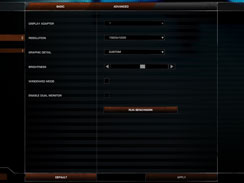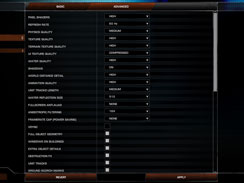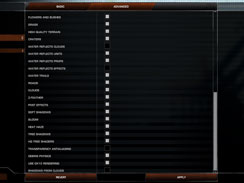World in Conflict
Publisher: SierraWe regard World in Conflict as one of the best real-time strategy games we've ever played. It's based on Microsoft's DirectX 10 API and, in collaboration with Nvidia's The Way It's Meant To Be Played developer support team, it incorporates some DirectX 10 specific graphics effects.
The first of these is a soft particle effect that removes the banding often found in particle effects like smoke, explosions, fire and debris - the effects simply didn't exist in the 3D world; instead, they were merely an add-on. With DirectX 10, the edges of the particle effects are much softer and banding is almost non-existent as the effects now interact with their 3D surroundings, as they're actually a part of the 3D world.
Additionally there are global cloud shadowing and volumetric lighting effects in the DirectX 10 version of the game. The latter is often referred to as 'god rays' and its implementation in World in Conflict interacts with the surroundings incredibly well. On the other hand, the former is where clouds cast shadows on the rest of the environment and, because all clouds in World in Conflict are volumetric and dynamic, the shadows cast by the clouds are rendered dynamically in DirectX 10 - they adjust in relation to the size, shape and orientation of the cloud in relation to the light source.
For our testing purposes, we used a full retail copy of the game and patched it to version 1.005, which includes a few fixes and some improved performance under DirectX 10. We used a manual run through from the Invasion level, which incorporates all of the effects we've discussed above. We chose not to use the built-in benchmark because it's largely CPU-limited. We used the "high" preset, and controlled anti-aliasing and anisotropic filtering via the advanced settings tab.
World in Conflict was another title where I was left scratching my head for a while, because performance at 1680x1050 2xAA was actually slower than at higher resolutions. No matter how many times I played through the section of the game I use for testing (along with other save points from the latter part of the singleplayer campaign), things didn’t change – the 3870 X2 and 3870 CrossFire configurations were just slower.
When we moved up to 1920x1200 and 2560x1600, performance was much more respectable. At 1920x1200 0xAA and 1920x1200 2xAA, the 3870 X2 fell behind the GeForce 8800 Ultra but matched the GTX if you only look at the average frame rate. The disappointing thing for the 3870 X2 though is that average frame rate is just one part of the equation and, even despite the lower averages, there were much better experiences to be had from the 8800 GTX.
The same was true at 2560x1600 0xAA 16xAF, where the 3870 X2 was the faster card if one only takes average frame rate into account, but it was again let down by choppy frame rates. I’d take the 8800 GTX—never mind the Ultra—over the 3870 X2 to play this game based on the current state of play because the smoothness (if it’s quantifiable) was at least an order of magnitude better on Nvidia’s long standing performance champ.

MSI MPG Velox 100R Chassis Review
October 14 2021 | 15:04












Want to comment? Please log in.